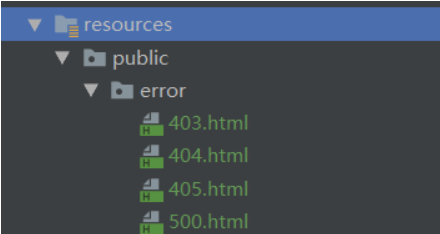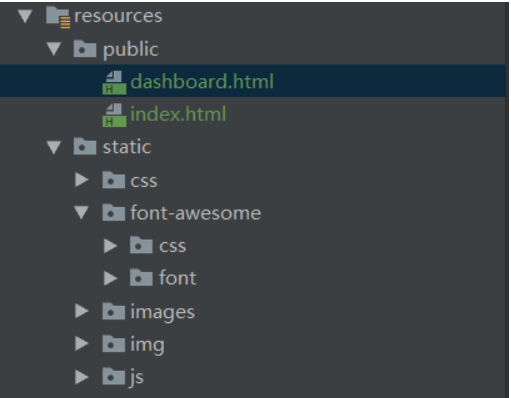一、引言
有了自动配置,springboot使web开发变得简单,这个在springboot之旅中的第一篇中就有体现,实际的开发中当然不会这么简单,很多时候我们都需要自己去定制一些东西。web开发的东西比较多, 我们先掌握一些必要知识点,剩下的就是CRUD开发。
快速的创建一个springboot web项目在第一篇总结中有讲:https://www.cnblogs.com/yuanqinnan/p/10604761.html
二、
现在大部分公司都是前后端分离的开发模式,一般作为后台开发不用关心前端,只需要提供相应接口,但是有关前端的知识我们最好还是能基本掌握一些。我们先了一套bootstrap框架,然后开始进行开发。
在之前的web开发中,在main目录下面会有webapp文件夹,我们将所有的静态资源放在里面,但是springboot的默认生成中并没有这个文件夹,那么springboot是怎么映射静态资源。
ctrl+N快捷键,找到WebMvcAutoConfiguration类,再找到里面的addResourceHandlers 方法
public void addResourceHandlers(ResourceHandlerRegistry registry) { if (!this.resourceProperties.isAddMappings()) { logger.debug("Default resource handling disabled"); return; } Duration cachePeriod = this.resourceProperties.getCache().getPeriod(); CacheControl cacheControl = this.resourceProperties.getCache() .getCachecontrol().toHttpCacheControl(); //webjar形式 if (!registry.hasMappingForPattern("/webjars/**")) { customizeResourceHandlerRegistration(registry .addResourceHandler("/webjars/**") .addResourceLocations("classpath:/META-INF/resources/webjars/") .setCachePeriod(getSeconds(cachePeriod)) .setCacheControl(cacheControl)); } //匹配/** String staticPathPattern = this.mvcProperties.getStaticPathPattern(); if (!registry.hasMappingForPattern(staticPathPattern)) { customizeResourceHandlerRegistration( registry.addResourceHandler(staticPathPattern) .addResourceLocations(getResourceLocations( //映射的资源文件夹 this.resourceProperties.getStaticLocations())) .setCachePeriod(getSeconds(cachePeriod)) .setCacheControl(cacheControl)); } }
2.1
<dependency> <groupId>org.webjars</groupId> <artifactId>jquery</artifactId> <version>3.3.1-1</version> </dependency>
引入后可以看到jquer文件被引入了:

另外当访问当前项目的任何资源,都去(静态资源的文件夹)找映射,资源文件夹是一个数组,包括:
"classpath:/META-INF/resources/", "classpath:/resources/","classpath:/static/", "classpath:/public/" ,
"/":当前项目的根路径。只要将静态文件放入其中,那么springboot就能找到。
三、
<dependency> <groupId>org.springframework.boot</groupId> <artifactId>spring-boot-starter-thymeleaf</artifactId> </dependency>
进入之后可以看到默认版本,我们也可以改成自己需要的版本。
<thymeleaf.version>3.0.9.RELEASE</thymeleaf.version> <!-- 布局功能的支持程序 thymeleaf3主程序 layout2以上版本 --> <!-- thymeleaf2 layout1--> <thymeleaf-layout-dialect.version>2.2.2</thymeleaf-layout-dialect.version>
@ConfigurationProperties(prefix = "spring.thymeleaf") public class ThymeleafProperties { private static final Charset DEFAULT_ENCODING = Charset.forName("UTF-8"); private static final MimeType DEFAULT_CONTENT_TYPE = MimeType.valueOf("text/html"); public static final String DEFAULT_PREFIX = "classpath:/templates/"; public static final String DEFAULT_SUFFIX = ".html";
我们可以去官网查看教程,这里只是简单的进行介绍,主要步骤
第一步:导入命名空间,导入之后会有相应提示
<html lang="en" xmlns:th="http://www.thymeleaf.org">
第二步:使用语法
<!DOCTYPE html> <html lang="en" xmlns:th="http://www.thymeleaf.org"> <head> <meta charset="UTF-8"> <title>Title</title> </head> <body> <h1>成功!</h1> <!--th:text 将div里面的文本内容设置为 --> <div><th th:text="${hello}"></th>这是显示欢迎信息</div> </body> </html>
更具体的使用方法,可以去查看官网教程,这种如果没有使用到的话不建议花太多时间去学,很多公司都是前后端分离,即使不是前后端分离,也有很多前端框架给我们使用。这些可以再我们使用的时候再去学习,速度也是很快的。
四、
springboot默认将为我们配置如下一些SpringMvc的必要组件:
-
必要的ViewResolver(视图解析器:根据方法的返回值得到视图对象(View)),如ContentNegotiatingViewResolver和
BeanNameViewResolver。 -
将必要的
Converter,GenericConverter,Formatter等bean注册到ioc容器中。 -
添加了一系列的
HttpMessageConverters以便支持对web请求和相应的类型转换。 -
自动配置和注册
MessageCodesResolver
任何时候,我们对默认提供的组件设定不满意,都可以注册新的同类型的bean定义来替换,web的所有自动场景都在org.springframework.boot.autoconfigure.web包中,我们可以参照进行配置。
当然完全靠自动配置在实际开发时不够的,我们经常需要自己配置一些东西,比如拦截器,视图映射规则。
@Configuration public class WebConfig implements WebMvcConfigurer { @Override public void addViewControllers(ViewControllerRegistry registry) { registry.addViewController("/yuan").setViewName("success"); } }
这段代码就实现了自定义的视图映射。上面这种写法使SpringMVC的自动配置和我们的扩展配置都会起作用
我们甚至可以全面接管springmvc,只要在配置类中增加@EnableWebMv注解,这样所有的SpringMVC的自动配置都失效了。当然,一般情况下我们不会这么做。
五、登陆
web系统一般少不了登录页面,我们先设定默认页面为登录页。
registry.addViewController("/").setViewName("login");
registry.addViewController("/index.html").setViewName("login");
@Controller public class LoginController { @PostMapping(value = "/user/login") public String login(@RequestParam("username") String username, @RequestParam("password") String password, Map<String,Object> map, HttpSession httpSession){ if(!StringUtils.isEmpty(username)&& "123456".equals(password)){ //设置session httpSession.setAttribute("loginUser",username); //重定向到主页 return "redirect:/main.html"; }else { map.put("msg","用户名密码错误"); return "login"; } } }
@Component public class LoginHandlerInterceptor implements HandlerInterceptor { public boolean preHandle(HttpServletRequest request, HttpServletResponse response, Object handler) throws Exception { Object user = request.getSession().getAttribute("loginUser"); if(user == null){ //未登陆,返回登陆页面 request.setAttribute("msg","没有权限请先登陆"); request.getRequestDispatcher("/index.html").forward(request,response); return false; }else{ //已登陆,放行请求 return true; } } }
然后再加入配置
@Configuration public class WebConfig implements WebMvcConfigurer { @Autowired private LoginHandlerInterceptor loginHandlerInterceptor; public void addInterceptors(InterceptorRegistry registry) { registry.addInterceptor(loginHandlerInterceptor).addPathPatterns("/**") .excludePathPatterns("/index.html","/","/user/login"); } }
这样在访问其他页面时都会进行登录拦截操作
六、
springboot有自身的默认错误处理机制,分为两种
第一种:浏览器,浏览器会返回一个默认的错误页面,如:

第二种:客户端,客户端默认返回的是一个响应一个json数据
如果我们用postman访问,则返回:

如果我们想要展示更加详细的信息,就将页面放在模板引擎文件夹下,路径名为 error/状态码,【将错误页面命名为错误状态码.html 放在模板引擎文件夹里面的 error文件夹下】,发生此状态码的错误就会来到 对应的页面。在这个页面我们可以获取到一些错误信息,如:
-
timestamp:时间戳
-
-
error:错误提示
-
exception:异常对象
-
message:异常消息
-
errors:JSR303数据校验的错误都在这里
我们可以根据这些错误信息来展示错误,一般不需要这么做,抛出的错误不应该让用户去分析,我们只需要返回静态页面即可,返回错误静态页面是做法也是一样的,只是我们不用将文件放在模板引擎文件夹下。

6.2.2 定制错误的json数据
在实际的开发中我们会对我们的错误码进行规范处理,根据错误会返回相应的错误码,所以我们会自己进行json数据包装处理。
@ControllerAdvice public class GlobalDefaultExceptionHandler { @ExceptionHandler(value = RequestException.class) public String requestExceptionHandler(RequestException e,HttpServletRequest request){ Map<String,Object> map = new HashMap<>(); //传入我们自己的错误状态码 4xx 5xx,否则就不会进入定制错误页面的解析流程 request.setAttribute("javax.servlet.error.status_code",500); map.put("code","user.notexist"); map.put("message",e.getMessage()); //转发到/error return "forward:/error"; } }
七、
@ConfigurationProperties(prefix = "server", ignoreUnknownFields = true) public class ServerProperties {
我们既可以修改通用的Servlet容器设置,如:
server:
port: 8089
也可以修改某一种容器的配置,如:
server:
tomcat:
uri-encoding: utf-8
7.2 、
注册三大组件用以下方式:
Servlet:ServletRegistrationBean
创建一个MyServlet类:
public class MyServlet extends HttpServlet { @Override public void doGet(HttpServletRequest req, HttpServletResponse resp) throws ServletException, IOException { doPost(req,resp); } @Override public void doPost(HttpServletRequest req, HttpServletResponse resp) throws ServletException, IOException { resp.getWriter().write("hello MyServlet"); } }
注入容器:
@Bean public ServletRegistrationBean myServlet(){ ServletRegistrationBean registrationBean = new ServletRegistrationBean(new MyServlet(),"/myServlet"); return registrationBean; }
public class MyFilter implements Filter { @Override public void init(FilterConfig filterConfig) throws ServletException { } @Override public void doFilter(ServletRequest servletRequest, ServletResponse servletResponse, FilterChain filterChain) throws IOException, ServletException { System.out.println("My filter process"); filterChain.doFilter(servletRequest,servletResponse); } @Override public void destroy() { } }
注入容器:
@Bean public FilterRegistrationBean myFilter(){ FilterRegistrationBean registrationBean = new FilterRegistrationBean(); registrationBean.setFilter(new MyFilter()); registrationBean.setUrlPatterns(Arrays.asList("/hello","/myServlet")); return registrationBean; }
public class MyListener implements ServletContextListener { @Override public void contextInitialized(ServletContextEvent sce) { System.out.println("contextInitialized ...web启动"); } @Override public void contextDestroyed(ServletContextEvent sce) { System.out.println("contextDestroyed ...web销毁"); } }
注入容器
@Bean public ServletListenerRegistrationBean myListener(){ ServletListenerRegistrationBean<MyListener> registrationBean = new ServletListenerRegistrationBean<>(new MyListener()); return registrationBean; }
7.3、
<!-- 引入web模块 --> <dependency> <groupId>org.springframework.boot</groupId> <artifactId>spring-boot-starter-web</artifactId> <exclusions> <exclusion> <artifactId>spring-boot-starter-tomcat</artifactId> <groupId>org.springframework.boot</groupId> </exclusion> </exclusions> </dependency> <!--引入其他的Servlet容器--> <dependency> <artifactId>spring-boot-starter-jetty</artifactId> <groupId>org.springframework.boot</groupId> </dependency>
Undertow:
<!-- 引入web模块 --> <dependency> <groupId>org.springframework.boot</groupId> <artifactId>spring-boot-starter-web</artifactId> <exclusions> <exclusion> <artifactId>spring-boot-starter-tomcat</artifactId> <groupId>org.springframework.boot</groupId> </exclusion> </exclusions> </dependency> <!--引入其他的Servlet容器--> <dependency> <artifactId>spring-boot-starter-undertow</artifactId> <groupId>org.springframework.boot</groupId> </dependency>
以上是我们在web开发需要先掌握的一些基本技术,有了这些基本知识之后,我们就可以进行CRUD开发,当然在实际的开发中,不管是登录拦截还是错误处理都比这个要复杂,我们以后再详讲。


